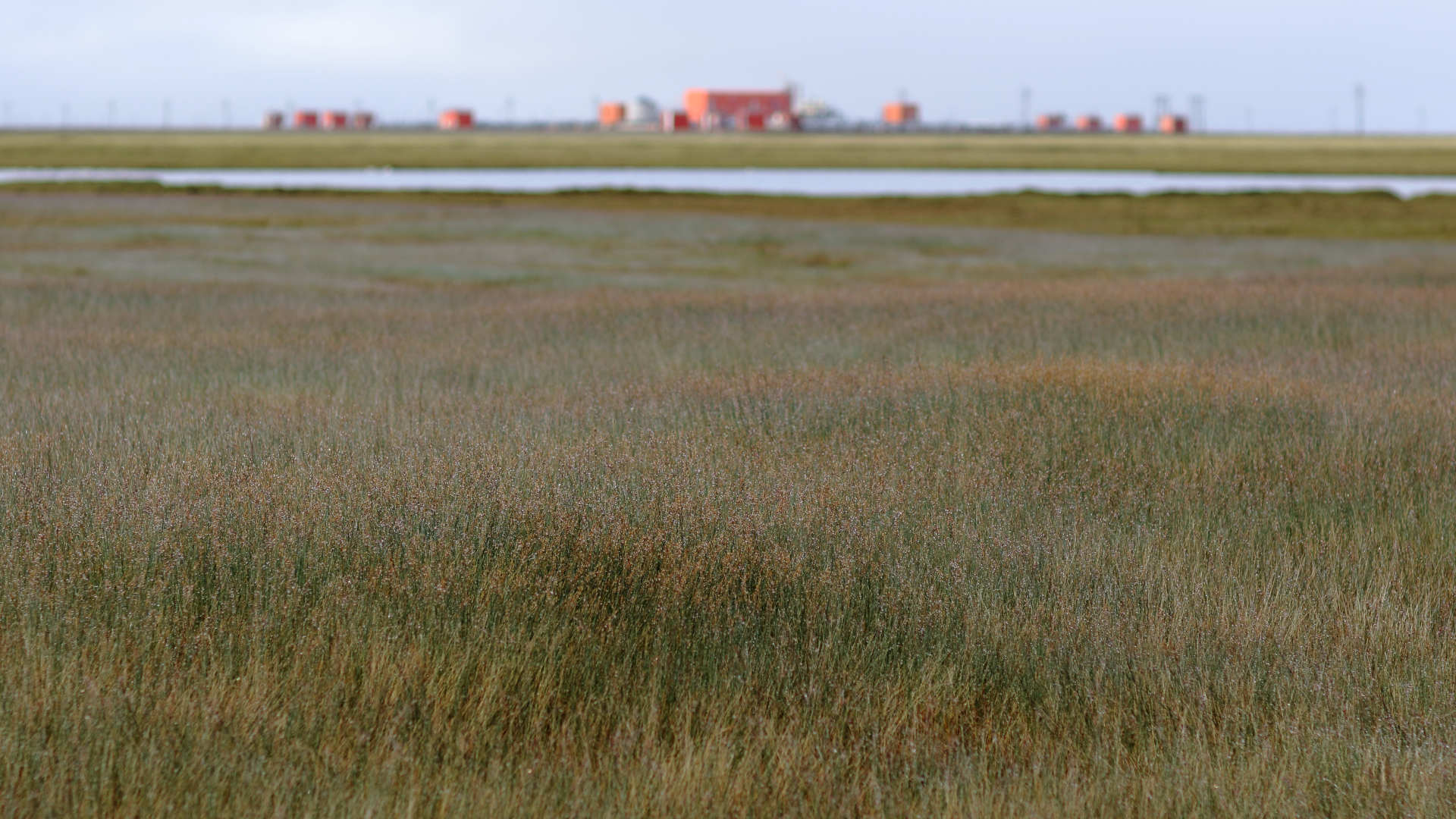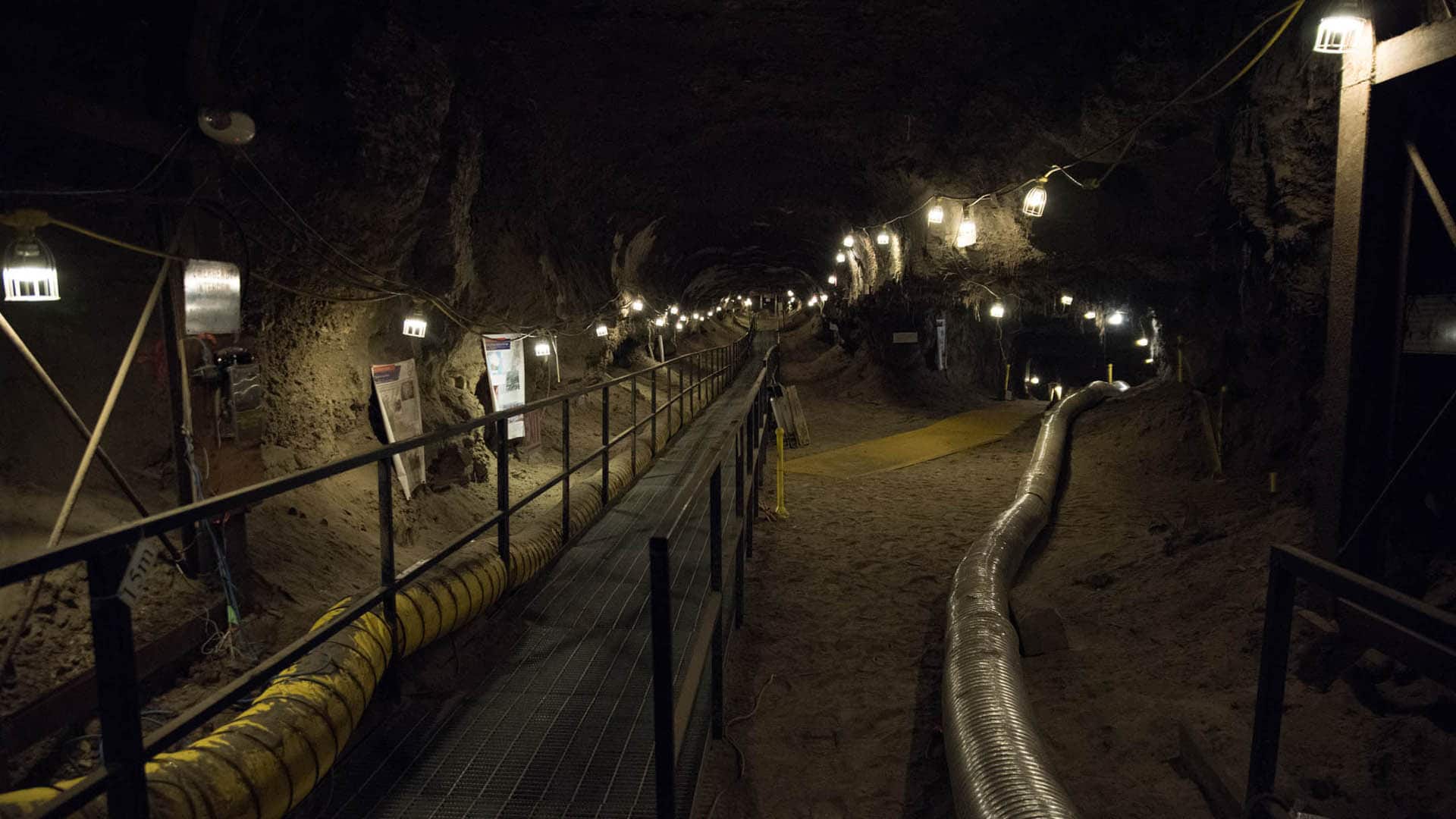Life on the coastal plain of Alaska exists on a scale difficult to capture. It’s a wild place where herds of caribou move around wolves and bears in wide arcs, musk oxen graze among dwarf willows, and gyrfalcons search the terrain for waterbirds. The tundra ground cover — a thick mat of damp, stunted vegetation — has sat atop the permafrost that’s existed since at least the last ice age.
Conspicuous clusters of bright metal buildings also dot this landscape: oil wells, storage tanks, and generators — all linked by a sprawling system of roads and pipelines. Prudhoe Bay, at the center of the north Alaskan coastal plain, is one of the largest oil fields in North America. More than 800 wells stretch across more than 300 square miles, drawing oil from deep underground.
Caribou migrate here across the imposing mountains of the Brooks Range unimpeded by human-made obstruction, only to bow their heads under pipelines when they reach the plains. Brown bears meander across the tundra under the watchful eye of oil workers, like teenagers shadowed by mall security. And wolves sniff the air to disentangle the mingling scents of prey and diesel.
In some ways this arrangement works. The oil companies, perhaps reluctant to attract additional public scrutiny, have imposed on themselves rules about how to live and work in the oil fields. Most travel directly on the tundra is forbidden for workers, and any interactions with animals are prohibited. For a place with so many roads and so much wildlife, vehicle strikes are surprisingly rare. The heart of this industrial landscape is unexpectedly clean.
Yet despite these safeguards, the ecosystem is thrown off balance. Oil infrastructure provides artificial nesting places for previously uncommon predators such as ravens. Red foxes, likely lured by anthropogenic sources of food and warmth, have moved into Prudhoe Bay to kill and displace Arctic foxes. Dust blowing off a gravel road may collect on adjacent land and hasten snowmelt. These disruptions — perhaps more than oil industry executives and the people who regulate them initially understood — have a long half-life.
The pursuit of oil is inherently ephemeral. Individual wells eventually dry up or cease to be profitable; whole fields dwindle. Companies pull stakes to move their carnival of drills, steel, and actors elsewhere across the coastal plain. The buildings may disappear, but ghosts of the infrastructure often remain. In the absence of adequate restoration plans, the disturbed environments will continue to impact local species for decades to come. Unlike the tropics, where human disturbances can be quickly repaired by new green growth, the Arctic remains fragile and exposed.
Oil companies have worked for decades to rehabilitate these fields with varying degrees of success. They strip gravel from old roads and obsolete drill pads to facilitate recovery, often reseeding the stripped area to return the land to a more natural state. At first glance, such sites may be difficult to distinguish from the surrounding vegetation, but on closer inspection, most show clear signs of past disturbance and some appear to have not recovered at all.
Restoration ecologists have found tundra difficult to restore. Though rather uncommon, salt on gravel sourced from the Arctic coastal plain may leach into the soil and inhibit new growth even after the rocks are taken away. Road removal projects sometimes strip too much gravel, exposing permafrost, accelerating melt, and turning what was once solid ground into a lake. Even when a site is successfully seeded with grass, geese can swoop in to feast on the fresh shoots, grazing these sites back to bare patches of mud.
For disturbed tundra to have any chance of recovering to a more natural state, oil companies and land management officials will need to consider new treatments. Tundra sodding, an under-utilized approach consistent with Indigenous Iñupiaq methods, seems to be the most promising intervention: When new oil infrastructure is created on existing tundra, the sod from that site could be carefully removed and fit atop an old drill site in need of restoration, much like plugging divots on a golf green. In current practice, oil companies usually just build new drill pads directly atop the existing sod, killing the ancient tundra cover in the process.
Successful caretaking of the Alaskan coastal plain will depend on a multitude of factors and will likely require decades of monitoring and adjustment, and a long-term commitment from industry and regulators. Key to this success will be for oil companies and environmental stakeholders to determine, upfront, the true costs of rehabilitation — financial and otherwise — and the tangible outcomes of different treatments. Such clarity could catalyze rehabilitation efforts in Alaska and elsewhere. This is not merely a retrospective exercise, but a forward-looking one.
In fact, the state of Alaska continues to eye the 1002 Area, a 2,300-square-mile section of the Arctic National Wildlife Refuge, despite a temporary moratorium on exploration and drilling within the Refuge. As exploration plans accelerate into this pristine landscape on the eastern border of the existing oil fields and elsewhere across the coastal plain, we still do not have viable and scalable tundra rehabilitation plans in place to address past actions, never mind what developers are eyeing next.
Oil companies and regulators must bolster nascent efforts to repair the damage that has already been done, and to ensure clean-up actions are built into the planning and implementation processes when expanding to new areas. We need to decide now what we want the coastal plain to look like in a hundred or a thousand years, after we have turned our attentions elsewhere.
Jonathan C. Slaght works for the Arctic Beringia Program of WCS (Wildlife Conservation Society). He is the author of “Owls of the Eastern Ice,” which won the 2021 PEN/E. O. Wilson Literary Science Writing Award, was named a New York Times Notable Book of 2020, and was long-listed for the National Book Award in Nonfiction.











